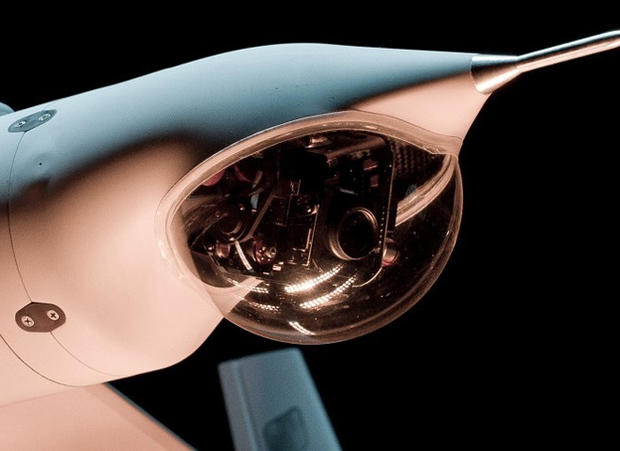How drones are changing the military
(CBS News) National security correspondent David Martin takes a look at what drones can do, and what they MAY be able to do someday:
Richard Phillips, captain of the container ship Maersk Alabama, was more than a little grateful when Seal Team Six rescued him from Somali pirates. He could have also thanked a little-known unmanned aircraft called ScanEagle.
While Phillips drifted in a life boat at the mercy of three armed pirates, ScanEagles kept watch overhead.
"They were giving some very good information in real time to the team that ultimately saved Captain Phillips," said Vice Admiral Mark Fox.
In the nearly four years since, Vice Admiral Fox, the director of Navy Operations, has witnessed a revolution in drone warfare.
"We are very much on the cusp, I think, of some remarkable changes in the way that we think about fighting," he said. "These unmanned systems are part of that."
Perhaps the most remarkable is the X-47B, a sleek test plane currently flying out of the Naval Air Station at Patuxent River, Md. Humans coax it into position for a catapult launch, but after that, it's flown entirely by computer.
Right now it's loaded only with instruments, but that could change once the Navy proves the X-47B can land and take off from a carrier at sea.
"That'll give you options to say, 'OK, maybe we should look at putting ordnance on it as well,'" said Vice Admiral Fox.
The X-47B could carry 4,000 pounds of weapons, and would take the danger out of attacking heavily-defended targets. "Obviously if you've got an unmanned aircraft in a very high threat environment, then you've got less risk to the air crew," Vice Admiral Fox said.
The Navy has been flying drones for several years now, but only as surveillance aircraft. Two $100 million Global Hawks are currently flying over the Persian Gulf.
Captain Jim Hoke is the program manager for this unmanned aircraft which has a wingspan nearly that of a commercial airliner, but can stay up much longer. "We can cover the entire Gulf when we're up at 60,000 feet," he said. "We burn less than a tenth of what a similar manned aircraft would burn for fuel, so we can stay up for 24 hours on a very little amount of gas."
During those 24 hours it can track every ship in the Persian Gulf, sending the data to Patuxent River for analysis, and then back to American warships in the Gulf.
"From the time that the picture is taken from the aircraft, to getting it back out there, is about less than seven minutes," Hoke said.
The Fire Scout -- an unmanned helicopter -- doesn't fly nearly so high but, says Captain Patrick Smith, it can do things airplanes can't.
"The main advantage we have from a helicopter is the vertical takeoff," said Captain Smith. "We can operate from a small deck of a ship. Or as we have deployments in Afghanistan, a very small, austere site only requiring a landing pad."
The Fire Scout is currently flying surveillance missions in a war zone. Its camera can send live television pictures of enemy positions to an operator 100 miles away. In fact, a Fire Scout has already given its life for its country.
"We did lose an aircraft in Libya over a year ago. That was attributed to an enemy action," said Captain Smith.
It was shot down. Soon, the Fire Scout will be able to shoot back. "The intent is for us to carry up to six rockets, and the testing will complete with that later this year."
We could make you dizzy by listing all the drones currently in operation - Predator and Reaper drones flying air strikes against suspected terrorists in Pakistan and Yemen; stealth drones flying spy missions over Iran. There's even one hauling cargo in Afghanistan.
No one wearing a military uniform will admit it, but the day seems to be coming when a drone can do anything a manned aircraft can do -- better.
For more info:
- AeroVironment
- DraganFly Innovations
- ScanEagle System (Insitu)
- X-47B (Northrop Grumman)
- Fire Scout (Northrop Grumman)
- "Living Under Drones: The Aftermaths of Drone Attacks" (Stanford Law School)
- Peter Singer, Brookings Institution
- University of North Dakota Aerospace
- Association for Unmanned Vehicle Systems International
- Mesa County Sheriff's Dept.
- Elevated Element (Terry & Belinda Kilby)
- Remote Control Aerial Photography Association

